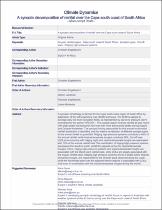JavaScript is disabled for your browser. Some features of this site may not work without it.
- ResearchSpace
- →
- Research Publications/Outputs
- →
- Journal Articles
- →
- View Item
| dc.contributor.author |
Engelbrecht, CJ

|
|
| dc.contributor.author |
Landman, WA

|
|
| dc.contributor.author |
Engelbrecht, FA

|
|
| dc.contributor.author |
Malherbe, Johan

|
|
| dc.date.accessioned | 2015-10-15T08:09:06Z | |
| dc.date.available | 2015-10-15T08:09:06Z | |
| dc.date.issued | 2015-05 | |
| dc.identifier.citation | Engelbrecht, CJ, Landman, WA, Engelbrecht, FA and Malherbe, J. 2015. A synoptic decomposition of rainfall over the Cape south coast of South Africa. Climate Dynamics, Vol 44, pp 2589–2607 | en_US |
| dc.identifier.issn | 0930-7575 | |
| dc.identifier.uri | http://link.springer.com/article/10.1007%2Fs00382-014-2230-5 | |
| dc.identifier.uri | http://hdl.handle.net/10204/8191 | |
| dc.description | 1. Copyright: 2014 Springer Verlag. Due to copyright restrictions, the attached PDF file only contains the abstract of the full text item. For access to the full text item, please consult the publisher's website. The definitive version of the work is published in Climate Dynamics | en_US |
| dc.description.abstract | A synoptic climatology is derived for the Cape south coast region of South Africa by application of the self-organizing map (SOM) technique. The SOM is applied to average daily low-level circulation fields, as represented by sea-level pressure anomalies for the period 1979–2011. This coastal region receives rainfall all-year round with slight peaks during March–April and with more pronounced peaks during August and October–November. The synoptic forcing responsible for this annual multi-modal rainfall distribution is identified, and the relative contribution of different synoptic types to the annual rainfall is quantified. Ridging high pressure systems contribute to 46 % of the annual rainfall, while tropical–temperate troughs contribute 28 %. Cut-off lows (COLs) co-occurring with ridging highs and tropical–temperate troughs are associated with 16 % of the annual rainfall total. The contribution of ridging high pressure systems decreases from south to north, whilst the opposite is true for tropical–temperate troughs. COLs, ridging high pressure systems and tropical–temperate troughs are associated with the March–April rainfall peak, while COLs are largely associated with the August rainfall peak. Ridging high pressure systems and to a lesser extent tropical–temperate troughs, are responsible for the October peak observed along the coast, while the November peak over the adjacent interior regions is associated with COLs that occur in combination with the tropical–temperate troughs during this month. | en_US |
| dc.language.iso | en | en_US |
| dc.publisher | Springer Verlag | en_US |
| dc.relation.ispartofseries | Workflow;14746 | |
| dc.subject | All-year rainfall region | en_US |
| dc.subject | South Africa Cape south coast | en_US |
| dc.subject | Synoptic types | en_US |
| dc.subject | Cut-off lows | en_US |
| dc.subject | Ridging high pressure systems | en_US |
| dc.title | A synoptic decomposition of rainfall over the Cape south coast of South Africa | en_US |
| dc.type | Article | en_US |
| dc.identifier.apacitation | Engelbrecht, C., Landman, W., Engelbrecht, F., & Malherbe, J. (2015). A synoptic decomposition of rainfall over the Cape south coast of South Africa. http://hdl.handle.net/10204/8191 | en_ZA |
| dc.identifier.chicagocitation | Engelbrecht, CJ, WA Landman, FA Engelbrecht, and Johan Malherbe "A synoptic decomposition of rainfall over the Cape south coast of South Africa." (2015) http://hdl.handle.net/10204/8191 | en_ZA |
| dc.identifier.vancouvercitation | Engelbrecht C, Landman W, Engelbrecht F, Malherbe J. A synoptic decomposition of rainfall over the Cape south coast of South Africa. 2015; http://hdl.handle.net/10204/8191. | en_ZA |
| dc.identifier.ris | TY - Article AU - Engelbrecht, CJ AU - Landman, WA AU - Engelbrecht, FA AU - Malherbe, Johan AB - A synoptic climatology is derived for the Cape south coast region of South Africa by application of the self-organizing map (SOM) technique. The SOM is applied to average daily low-level circulation fields, as represented by sea-level pressure anomalies for the period 1979–2011. This coastal region receives rainfall all-year round with slight peaks during March–April and with more pronounced peaks during August and October–November. The synoptic forcing responsible for this annual multi-modal rainfall distribution is identified, and the relative contribution of different synoptic types to the annual rainfall is quantified. Ridging high pressure systems contribute to 46 % of the annual rainfall, while tropical–temperate troughs contribute 28 %. Cut-off lows (COLs) co-occurring with ridging highs and tropical–temperate troughs are associated with 16 % of the annual rainfall total. The contribution of ridging high pressure systems decreases from south to north, whilst the opposite is true for tropical–temperate troughs. COLs, ridging high pressure systems and tropical–temperate troughs are associated with the March–April rainfall peak, while COLs are largely associated with the August rainfall peak. Ridging high pressure systems and to a lesser extent tropical–temperate troughs, are responsible for the October peak observed along the coast, while the November peak over the adjacent interior regions is associated with COLs that occur in combination with the tropical–temperate troughs during this month. DA - 2015-05 DB - ResearchSpace DP - CSIR KW - All-year rainfall region KW - South Africa Cape south coast KW - Synoptic types KW - Cut-off lows KW - Ridging high pressure systems LK - https://researchspace.csir.co.za PY - 2015 SM - 0930-7575 T1 - A synoptic decomposition of rainfall over the Cape south coast of South Africa TI - A synoptic decomposition of rainfall over the Cape south coast of South Africa UR - http://hdl.handle.net/10204/8191 ER - | en_ZA |






